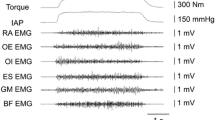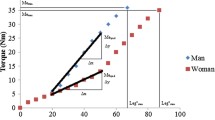Abstract
Purpose
Muscle size of the hamstring and gluteus maximus (GM) as well as intra-abdominal pressure (IAP) are considered as factors affecting the torque development during hip extension. This study examined the associations of torque development during maximal voluntary isometric hip extension with IAP and muscle size of the hamstring and GM.
Methods
Anatomical cross-sectional area (ACSA) of the hamstring and thickness of GM were determined in 20 healthy young males using an ultrasonography apparatus (Experiment 1). Torque and IAP were simultaneously measured while subjects performed maximal voluntary isometric hip extension. The IAP was measured using a pressure transducer placed in the rectum and determined at the time at which the developed torque reached to the maximal. In Experiment 2, torque and IAP were measured during maximal voluntary isometric hip flexion in 18 healthy young males.
Results
The maximal hip extension torque was significantly correlated with the IAP (r = 0.504, P = 0.024), not with the ACSA of the hamstring (r = 0.307, P = 0.188) or the thickness of GM (r = 0.405, P = 0.076). The relationship was still significant even when the ACSA of the hamstring and the thickness of GM were adjusted statistically (r = 0.486, P = 0.041). The maximal hip flexion torque was not significantly correlated with the IAP (r = −0.118, P = 0.642).
Conclusion
The current results suggest that IAP can contribute independently of the muscle size of the agonists to maximal voluntary hip extension torque.




Similar content being viewed by others
Abbreviations
- ACSA:
-
Anatomical cross-sectional area
- EFOV:
-
Extended field-of-view
- GM:
-
Gluteus maximus
- IAP:
-
Intra-abdominal pressure
- MVC:
-
Maximal voluntary contraction
References
Aagaard P, Simonsen EB, Andersen JL, Magnusson P, Dyhre-Poulsen P (2002) Neural adaptation to resistance training: changes in evoked V-wave and H-reflex responses. J Appl Physiol 92:2309–2318
Athanasios T, Eleftherios K, Athanasios J, Spiros K (2002) The relationship between jumping performance and isokinetic strength of hip and knee extensors and ankle plantar flexors. Isokinet Exerc Sci 10:107–115
Blazevich AJ, Coleman DR, Horne S, Cannavan D (2009) Anatomical predictors of maximum isometric and concentric knee extensor moment. Eur J Appl Physiol 105:869–878
Cholewicki J, Juluru K, McGill SM (1999) Intra-abdominal pressure mechanism for stabilizing the lumbar spine. J Biomech 32:13–17
Evangelidis PE, Massey GJ, Pain MT, Folland JP (2016) Strength and size relationships of the quadriceps and hamstrings with special reference to reciprocal muscle balance. Eur J Appl Physiol 116:593–600
Fukunaga T, Miyatani M, Tachi M, Kouzaki M, Kawakami Y, Kanehisa H (2001) Muscle volume is a major determinant of joint torque in humans. Acta Physiol Scand 172:249–255
Hagins M, Pietrek M, Sheikhzadeh A, Nordin M (2006) The effects of breath control on maximum force and IAP during a maximum isometric liting task. Clin Biomech 21:775–780
Hoshikawa Y, Iida T, Muramatsu M, Ii N, Nakajima Y, Chumank K, Kanehisa H (2013) Effects of stabilization training on trunk muscularity and physical performance in youth soccer players. J Strength Cond Res 27:3142–3149
Ikeda ER, Borg A, Brown D, Malouf J, Showers KM, Lis S (2009) The valsalva maneuver revisited: the influence of voluntary breathing on isometric muscle strength. J Strength Cond Res 23:127–132
Jamison ST, McNeilan RJ, Young GS, Givens DL, Best TM, Chaudhari AM (2012) Randomized controlled trial of the effects of a trunk stabilization program on trunk control and knee loading. Med Sci Sports Exerc 44:1924–1934
Janssen I, Heymsfield SB, Ross R (2002) Low relative skeletal muscle mass (sarcopenia) in older persons is associated with functional impairment and physical disability. J Am Geriatr Soc 50:889–896
Kawabata M, Shima N, Hamada H, Nakamura I, Nishizono H (2010) Changes in intra-abdominal pressure and spontaneous breath volume by magnitude of lifting effort: highly trained athletes versus healthy men. Eur J Appl Physiol 109:279–286
Kibler WB, Press J, Sciascia A (2006) The role of core stability in athletic function. Sports Med 36:189–198
Lord SR, Lloyd DG, Nirui M, Raymond J, Williams P, Stewart RA (1996) The effect of exercise on gait patterns in older women: a randomized controlled trial. J Gerontol A Biol Sci Med Sci 51:64–70
Masuda K, Kikuhara N, Takahashi H, Yamanaka K (2003) The relationship between muscle cross-sectional area and strength in various isokinetic movements among soccer players. J Sports Sci 21:851–858
McGill SM, Nroman RW, Sharratt MT (1990) The effect of an abdominal belt on trunk muscle activity and intra-abdominal pressure during squat lifts. Ergonomics 33:147–160
Munro BH (2005) Statistical methods for health care research, 5th edn. Lippincott Williams & Wilkins, Philadelphia
Narici MV, Roi GS, Landoni L, Minetti AE, Cerretelli P (1989) Changes in force, cross-sectional area and neural activation during strength training and detraining of the human quadriceps. Eur J Appl Physiol Occup Physiol 59:310–319
Prieske O, Muehlbauer T, Borde R, Gube M, Bruhn S, Behm DG, Granacher U (2016) Neuromuscular and athletic performance following core strength training in elite youth soccer: role of instability. Scand J Med Sci Sports 26:48–56
Stokes IA, Gardner-Morse MG, Henry SM (2010) Intra-abdominal pressure and abdominal wall muscular function: spinal unloading mechanism. Clin Biomech 25:859–866
Tayashiki K, Takai Y, Maeo S, Kanehisa H (2016a) Intra-abdominal pressure and trunk muscular activities during abdominal bracing and hollowing. Int J Sports Med 37:134–143
Tayashiki K, Maeo S, Usui S, Miyamoto N, Kanehisa H (2016b) Effect of abdominal bracing training on strength and power of lower limb muscles. Eur J Appl Physiol 116:1709–1713
Usui S, Maeo S, Tayashiki K, Nakatani M, Kanehisa H (2016) Low-load slow movement squat training increases muscle size and strength but not power. Int J Sports Med 37:305–312
Willardson JM (2007) Core stability training: applications to sports conditioning programs. J Strength Cond Res 21:979–985
Worrell TW, Karst G, Adamczyk D, Moore R, Stanley C, Steimel B, Steimel S (2001) Influence of joint position on electromyographic and torque generation during maximal voluntary isometric contractions of the hamstrings and gluteus maximus muscles. J Orthop Sports Phys Ther 31:730–740
Yamauchi J, Ishii N (2007) Relations between force–velocity characteristics of knee-hip extension movement and vertical jump performance. J Strength Cond Res 21:703–709
Acknowledgements
This work was partly supported by JSPS KAKENHI (26350748).
Author information
Authors and Affiliations
Corresponding author
Ethics declarations
Conflict of interest
The authors report no conflicts of interest associated with manuscript.
Additional information
Communicated by Toshio Moritani.
Rights and permissions
About this article
Cite this article
Tayashiki, K., Hirata, K., Ishida, K. et al. Associations of maximal voluntary isometric hip extension torque with muscle size of hamstring and gluteus maximus and intra-abdominal pressure. Eur J Appl Physiol 117, 1267–1272 (2017). https://doi.org/10.1007/s00421-017-3617-x
Received:
Accepted:
Published:
Issue Date:
DOI: https://doi.org/10.1007/s00421-017-3617-x




